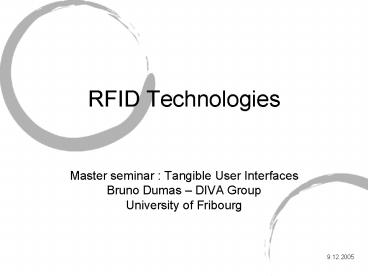RFID Technologies - PowerPoint PPT Presentation
Title: RFID Technologies
1
RFID Technologies
- Master seminar Tangible User Interfaces
- Bruno Dumas DIVA Group
- University of Fribourg
9.12.2005
2
Presentation summary
- RFID ?
- Base of the technology
- Technical aspects
- Advantages Limitations
- Standard applications
- Applications to TUIs
- Conclusion
3
RFID ?
- RFID -gt Radio Frequency IDentification
- Derived from early military technology (russian
bugs, 1939 Allied IFF systems, etc.) - First papers on the RFID theory in the 60s
- First high scale deployments in the 90s
- 21st century RFID everywhere ?
4
Base of the Technology
- Necessary elements a reader and a tag
- Reader sends a wave at a given frequency
- If a tag is close enough to the reader, it will
receive the wave - The tag is designed to take advantage of the wave
energy to send back an answer, enclosing (for
example) its identity
5
Base of the technology
?
6
Technical aspects Tags
- Different types of tags
- (Pure) passive
- Semi-active (same technology than passive tags,
but battery assisted) - Active (contain a transceiver, battery assisted)
Increase in read range, but also in price !
7
Technical Aspects frequencies
- RFID operates at different frequencies
Freqency Price range Read Range Limitations Applications
Low frequency 125-134 kHz low Low ( lt 1 m.) Low reading speed Animal/Container tracking
High Frequency 13.56 Mhz Low to Middle Low ( lt 1.5 m) Problems with metal Library, access control
Ultra-high freq. 860-930 MHz Middle to High High ( gt 10 m) Interference problems Pallet/Vehicle tracking
Microwave 2.4 GHz High High ( gt 50 m) Not widely deployed Vehicle access control
8
Technical aspects protocols
- Numerous protocols
- Really numerous
- ISO standards
- Industry-defined (EPC) standards
- US Department of Defense standards
- And lots of proprietary solutions
9
Technical aspects Protocols
- Proof by example the 860-930 Mhz range
10
Advantages
As Sokymat says
But sometimes very low range
Mainly valid for high frequency tags
Depends of the material
Not all tags have this functionality
Only valid for low frequency tags
11
Limitations
- Read range (for passive tags, less than 1 meter
in most cases, sometimes even less than a few cm
!) - Security (nothing at this time, at least among
the standards planned ?) - Multi-tag management (collision problems with
some types of readers and tags) - Interferences with metals and liquids
- No unification between the different protocols
12
Case study US Passport
- The US decided to introduce RFID chips into their
new passport - Goal easily integrate machine reading of
personal and biometrics data - All this with no security at all
- They were finally told of the dangers and
reviewed the concept - The new passport contains encryption,
shielding, some sort of PIN code
13
Real advantages
- Cost will necessarily go down
- As a replacement for the bar code, good
technology - Linked with other technologies (like GPS or
sensors), can become really attractive
14
Standard Applications
- Presented as a successor of the bar code (which
shall still remain in place a few years, though) - Supply chain
- Traceability
- Animal Identification
- Checkpoint systems
15
Application to TUIs
- Augmented documents
- Tangible bookmarks
- Easy interfacisation of random objects
- Etc
- What could be the limit when every product is
tagged ?
16
Conclusion
- Present state of the RFID
- Nonetheless, will be a major piece of our future
- Dearly desired by the industry
- Desirable for the TUI research
- as a tool
- mixed with other technologies ?
17
Final anecdote
- Some fundamentalist Christians firmly believe
that RFID is in reality - The Mark of the Beast !!!
- (Cf. Wikipedia.org for more details )
18
Questions ?
19
References
- http//en.wikipedia.org/wiki/RFID
- K. Finkenzeller, RFID handbook fundamentals and
applications in contactless smart cards and
identification, Wiley Sons 2004. - S. Shepard, RFID radio frequency
identification, McGraw Hill 2005. - RFID a week long survey on the technology and
its potential - Bridging Physical and Virtual Worlds with
Electronic Tags - Real Applications using RFID tags
- AIM RFID Emblem































